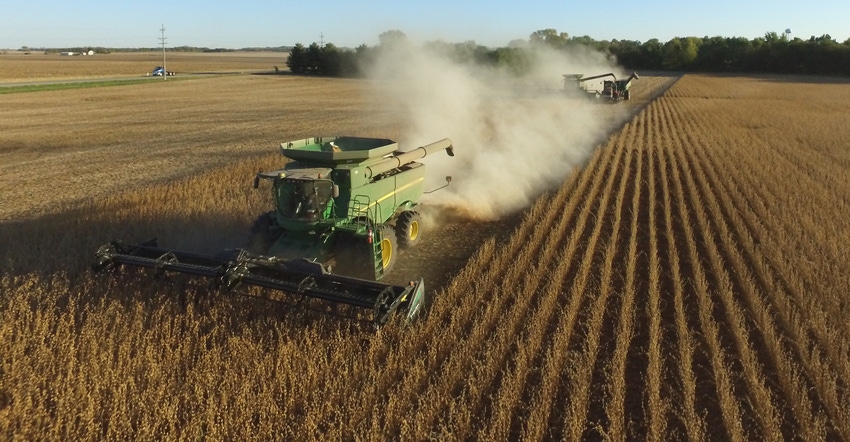
What’s it mean to an Illinois farmer’s marketing plan when headlines read: “Taiwan commits to buy $2.2 billion in Illinois corn and soybeans” or “Japan agrees to $7 billion in U.S. products”?
Not a whole lot, says Bryce Knorr, senior market analyst for Farm Futures, who calls those headlines window dressing and good publicity for Midwest state governors.
“Trade deals that don’t lower or eliminate tariffs won’t do anything to help exports,” he says. “Countries don’t buy stuff they don’t need.”
Knorr explains that countries — and more specifically, companies in those countries — only buy grain when they need it and when it’s priced appropriately. As an example, China was granted a waiver on tariffs, allowing companies to buy 367 million bushels of soybeans. So far, they’ve bought 7 million bushels.
They’re buying slowly because new-crop soybean prices in Brazil are cheaper than soybeans coming out of the Gulf of Mexico. End users won’t buy something in one place if it’s cheaper in another.
Feed makers in South Korea, for example, used to be one of the U.S.’ biggest feed buyers. The Trump administration renegotiated a Korean trade deal a year ago, but today the country is buying its corn from Brazil. South Korea’s total commitments for 2019-crop corn are 2.75 million bushels; a year ago, that figure was 66.25 million bushels. Why? Last year, prices were cheap and freight was available because the U.S. wasn’t shipping soybeans to China. This year, China is a buying a little more, plus Brazil’s huge crop is swamping the market.
“You can do all the trade deals you want,” Knorr says of these letters of intent. “But in most countries, governments aren’t buying commodities. Companies are.”
Farmers can’t get excited about goodwill agreements because they don’t know when or if they’ll happen. And they likely won’t happen soon. Knorr points out, “China made all these commitments last week and soybeans ended up basically unchanged. They’re not buying right now.”
He calls 1970s Russia the classic example of not living up to commitments. “They said they’d buy all this stuff and they almost never did — only time they did was when they had bad crops.”
Knorr says this is exactly why the Trans-Pacific Partnership was such a loss overall to agriculture, because it dealt with reducing actual structural trade barriers. TPP was opposed by both Donald Trump and Hillary Clinton, and Trump pulled the U.S. out of the landmark agreement following his election. The remaining 11 countries formed a new pact without the U.S., loosely known at TPP-11.
Come to our house
So why host trade missions regularly? Because people are still people, and relationships are still important in business.
Bobby Dowson, international marketing representative for the Illinois Department of Agriculture, calls them goodwill missions, not contracts or direct purchases.
“It’s really a proclamation to keep our friendship,” says Dowson, who’s hosted international groups for 24 years for IDOA, and who did this interview standing with a group of Mexican cattle producers en route to an Illinois Angus sale.
Dowson says the Taiwanese come to the U.S. every two to three years and often include Illinois on their trip so they can build relationships with Illinois corn and soybean producers. The media event is also good PR for the Taiwanese, who like to go back home and show themselves on television with the farmers who grow their soybeans.
“They like the trip and the publicity, too,” he says.
Historically, Taiwan has been a top five importer of U.S. soybeans, and the country uses these trips to pledge continued purchases. “They’re an island trying to produce livestock; they have to buy soybeans,” Dowson points out.
On their trip in September, the Taiwan Vegetable Oil Manufacturers Association signed a letter of intent with the Illinois Soybean Association to buy 2.6 million metric tons of soybeans. The Taiwan Feed Industry Association signed a similar letter of intent with IL Corn to buy 5 million metric tons of corn and 0.5 million metric tons of corn coproducts.
What matters
Beyond economics, Knorr says Taiwan has political reasons to do business with U.S. farmers, even if grain is cheaper out of Ukraine, Russia, Brazil or Argentina.
“They’ll do everything they can to curry favor with the U.S. because of that big country next door with 1.3 billion people,” Knorr says, referring to China. “It’s in their interest to be a loyal customer. Brazil isn’t going to give them fighter jet planes.”
And while letters of intent proclaim a buy of “Illinois” corn and soybeans, in reality, commodities aren’t sorted by state. Barges loaded from an elevator on the river get an export certificate. While a majority of the grain may well be from Illinois, the reality is that elevators take grain from both sides of the river — and it’s hard to track every bean and every kernel of corn. Export accountants work off an equation, Dowson explains, and since Illinois is the No. 1 soybean-producing state, it gets a little bigger part of the equation.
“It’s not an exact science,” he says. But it’s still good for Illinois farmers, who export more than 360 million bushels of soybeans and 877 million bushels of corn annually.
And it’s still important to bring buyers to meet Illinois farmers, thank them for their purchases and make them comfortable with what U.S. farmers are doing.
Just don’t change your marketing plan based on a goodwill headline, Knorr says. “Traders look at data — not press releases. That’s what drives prices, and that’s what should drive farmers’ marketing plans.”
In the end, Knorr says only one thing will help level the playing field with international competitors: “Have a good quality product at a fair price.”
About the Author(s)
You May Also Like






